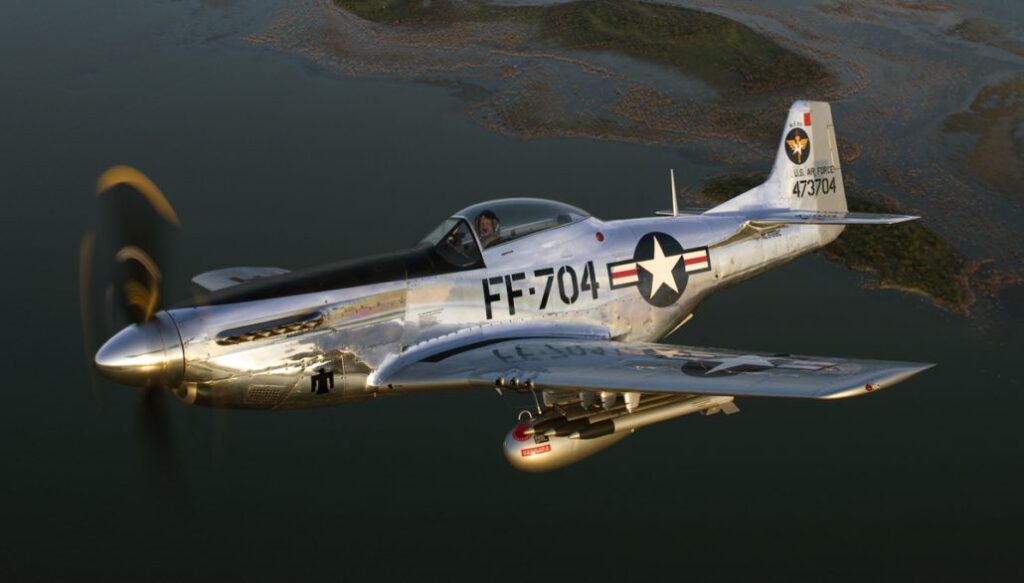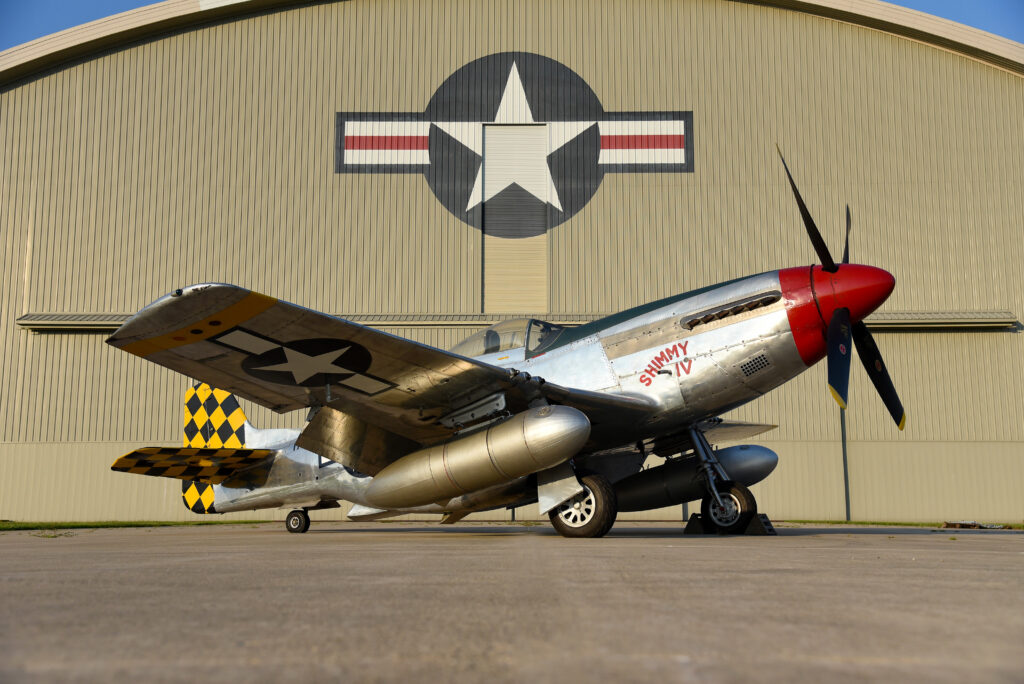The P-51 Mustang, an American long-range single-seat fighter aircraft, holds a special place in the annals of aviation history. Its legendary status is not unfounded, as it dominated the skies during World War II and beyond. In this comprehensive guide, we delve into the 10 reasons why the P-51 Mustang soared above the rest, uncovering the traits and innovations that made it an unparalleled force in aerial combat.
Evolution of Aviation Technology
The P-51 Mustang emerged during a critical period of technological advancement in aviation. It capitalized on innovations in aerodynamics, engine design, and materials to achieve unprecedented performance.
Cutting-Edge Aerodynamics
At the heart of the P-51’s success lay its sleek and aerodynamic design. With its laminar flow wing and streamlined fuselage, the Mustang minimized drag and maximize speed, giving it a crucial edge in combat.
Revolutionary Engine
A key factor in the Mustang’s performance was its powerful Rolls-Royce Merlin engine. This V-12 engine provided exceptional horsepower and reliability, propelling the aircraft to unmatched speeds and altitudes.
Superior Combat of P-51 Mustang Capabilities
The P-51 Mustang was not just a marvel of engineering; it was a formidable combatant in the skies. Its combination of speed, firepower, and agility made it a nightmare for enemy pilots.
High-Speed Maneuverability
One of the standout features of the Mustang was its agility at high speeds. Unlike many contemporary fighters, the P-51 excelled in both dogfights and high-speed intercepts, giving pilots a versatile edge in combat scenarios.
Lethal Firepower
Armed with six .50 caliber Browning machine guns, the P-51 packed a devastating punch. Its formidable armament allowed it to take on enemy aircraft with confidence, earning it a reputation as a fearsome adversary.
Extended Range and Endurance
In the theater of war, range, and endurance are critical factors for success. The P-51 Mustang’s ability to fly long distances without refueling gave it a strategic advantage over other fighters.
Escort Role in Strategic Bombing Campaigns
One of the most significant contributions of the P-51 was its role as a long-range escort for Allied bombers. By providing cover deep into enemy territory, the Mustang helped turn the tide of the war in favor of the Allies.
Transatlantic Capability
With the addition of external fuel tanks, the P-51 had the range to accompany bombers on missions deep into Nazi-occupied Europe. This extended reach allowed for strategic strikes against vital enemy targets.
Versatility in Combat Roles
Flexibility is a hallmark of any successful aircraft, and the P-51 Mustang was no exception. Its adaptability to various roles ensured its effectiveness in diverse combat scenarios.
Fighter Escort
The primary role of the P-51 was to escort bombers and protect them from enemy fighters. Its long-range capabilities and formidable firepower made it the ideal guardian for Allied aircrews.
Ground Attack
In addition to its escort duties, the P-51 proved adept at ground attack missions. Equipped with bombs and rockets, it could strike enemy targets with precision, wreaking havoc on enemy infrastructure.
Technological Innovations
The P-51 Mustang was at the forefront of technological innovation during its time. From its advanced engine to its cutting-edge weaponry, every aspect of the aircraft pushed the boundaries of what was possible in aviation.
Merlin Engine
The Rolls-Royce Merlin engine was a masterpiece of engineering, delivering unparalleled performance and reliability. Its supercharged design allowed the Mustang to operate at high altitudes, giving it a crucial advantage over enemy aircraft.
Armament Upgrades
Over the course of its production, the P-51 saw numerous upgrades to its armament. From additional machine guns to rocket pods, these enhancements further enhanced its combat capabilities, ensuring it remained a potent force in the air.
Iconic Design
The silhouette of the P-51 Mustang is instantly recognizable to aviation enthusiasts around the world. Its iconic design not only captured the imagination but also reflected its exceptional performance capabilities.
Streamlined Fuselage
The sleek lines of the Mustang’s fuselage were more than just aesthetically pleasing; they were designed for maximum aerodynamic efficiency. This streamlined profile reduced drag and improved overall performance, contributing to the aircraft’s success in combat.
Distinctive Wing Configuration
The distinctive shape of the P-51’s wings was another engineering triumph. Their low drag profile and efficient airfoil design provided superior lift and stability, allowing for precise control in all flight regimes.
Impact on Air Superiority
The introduction of the P-51 Mustang had a profound impact on the balance of air power during World War II. Its arrival heralded a new era of Allied dominance in the skies.
Turning the Tide of the Air War
With its ability to escort bombers deep into enemy territory, the P-51 played a pivotal role in gaining air superiority over Europe. Its presence forced the Luftwaffe to divert resources from the Eastern Front, ultimately weakening the Axis war machine.
Strategic Significance
The strategic significance of the P-51 cannot be overstated. By providing crucial air support for ground operations and disrupting enemy supply lines, it played a decisive role in the Allied victory in Europe.
Legacy and Continued Influence
Even after the end of World War II, the legacy of the P-51 Mustang endured. Its impact on aviation technology and tactics reverberated for decades to come.
Post-War Service
Following the war, many surplus P-51s found new life in various air forces around the world. Their continued service showcased the enduring reliability and versatility of the aircraft.
Racing and Air Shows
In civilian hands, the P-51 became a staple of air racing and air shows. Its speed and agility made it a crowd favorite, further cementing its status as an aviation icon.
Cultural Significance
Beyond its military accomplishments, the P-51 Mustang holds a special place in popular culture. Its sleek lines and storied history have captured the imagination of generations.
Hollywood Fame
The P-51 has appeared in numerous films and television shows, immortalizing its image in popular media. Its portrayal on the silver screen has helped preserve its legacy for future generations.
Symbol of Freedom
For many, the P-51 represents more than just a machine of war; it symbolizes the spirit of freedom and perseverance. Its role in defending democracy during World War II serves as a reminder of the sacrifices made to safeguard liberty.
Enduring Inspiration
Even in the modern era, the P-51 Mustang continues to inspire aviation enthusiasts and historians alike. Its timeless design and unparalleled performance serve as a testament to the ingenuity and bravery of those who flew it.
Museums and Memorials
Numerous museums and memorials around the world pay homage to the P-51 and its contributions to aviation history. These exhibits ensure that future generations can appreciate the legacy of this iconic aircraft.
Living History
Thanks to dedicated pilots and enthusiasts, the P-51 remains a fixture at airshows and fly-ins. Seeing the Mustang in flight offers a glimpse into the past and a reminder of the daring feats achieved by those who piloted it.
FAQs (Frequently Asked Questions)
- What made the P-51 Mustang stand out during World War II?
- The P-51’s combination of range, speed, and firepower set it apart from other fighters of its time, allowing it to excel in various roles, including bomber escort and ground attack missions.
- How did the P-51 contribute to the Allied victory in Europe?
- By providing long-range escort for Allied bombers, the P-51 helped secure air superiority over Europe, crippling enemy war efforts and paving the way for ground offensives.
- Was the P-51 Mustang used in any other conflicts besides World War II?
- Yes, the P-51 saw service in various conflicts, including the Korean War, where it continued to demonstrate its effectiveness in combat.
- What advancements in technology were incorporated into the P-51 Mustang?
- The P-51 featured innovations such as the Rolls-Royce Merlin engine, laminar flow wings, and advanced armament, all of which contributed to its superior performance.
- How does the P-51 Mustang compare to other fighter aircraft of its era?
- The P-51 outclassed many of its contemporaries in terms of range, speed, and firepower, making it one of the most formidable fighters of World War II.
- What is the cultural significance of the P-51 Mustang?
- The P-51 holds a special place in popular culture as a symbol of freedom and American ingenuity, with its sleek design and storied history captivating audiences worldwide.
Conclusion:
The P-51 Mustang’s legacy as a legendary aircraft is undeniable. From its revolutionary design to its pivotal role in shaping history, the Mustang continues to inspire awe and admiration. As we reflect on its 10 reasons for soaring above the rest, we recognize not only its technological prowess but also the courage and skill of the pilots who flew it into combat.
